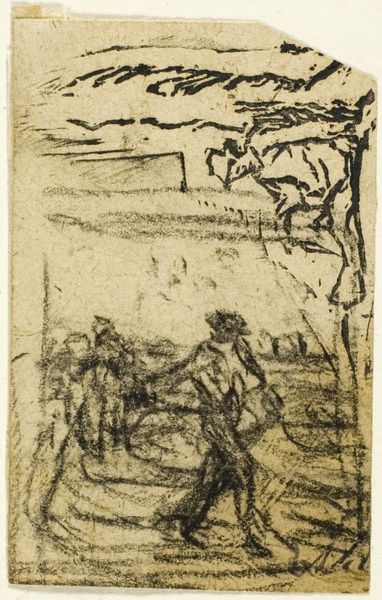
drawing, print, etching, paper
#
drawing
# print
#
impressionism
#
etching
#
landscape
#
etching
#
figuration
#
paper
#
genre-painting
Dimensions: 69 × 72 mm (image/plate); 331 × 240 mm (sheet)
Copyright: Public Domain
Editor: We’re looking at “Souvenir of Coney Island,” an etching by Robert Frederick Blum from 1880. The carefree figures evoke memories of youthful freedom and summertime. It's quite small, almost intimate in scale. What sort of imagery and visual storytelling jumps out at you in this piece? Curator: This seemingly simple scene overflows with the symbolism of American leisure at the turn of the century. Note the children—representative of innocence, yes, but also a burgeoning national identity being shaped by experiences of leisure and play. Their positioning—some directly engaging, others more withdrawn—mirrors the complex relationship Americans were developing with public spaces and emerging mass culture. Does the etching medium itself suggest anything to you? Editor: It almost makes it feel ephemeral… Like a fleeting moment. Curator: Precisely. Etchings like this were easily reproducible, making art accessible to a wider audience and democratizing the viewing experience. What do you observe in the composition, especially the lines and marks? Consider how those lines themselves create a sense of motion or stillness. Editor: There’s so much frenetic energy, but at the same time the blank areas also draw my eye, forcing me to slow down, creating a quiet, reflective feeling…almost nostalgic. Curator: The balance you describe highlights a core tension in American identity—the pull between constant motion and a longing for tranquility. The etching captures the beginning of Coney Island as a dreamscape, where ordinary life meets extraordinary possibility. A place where memories, etched in our minds, become our souvenirs. What has struck you most? Editor: That what seems like a straightforward scene is packed with social and cultural significance! Curator: Exactly. It shows how everyday moments can tell compelling stories about who we are, what we value, and how our collective memories are shaped.
Comments
No comments
Be the first to comment and join the conversation on the ultimate creative platform.













